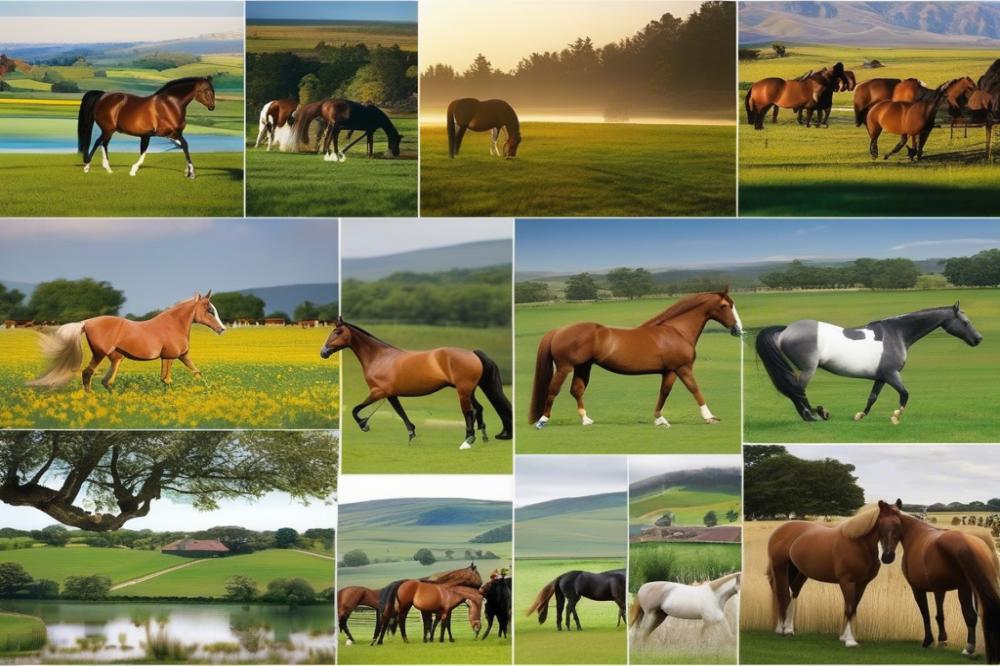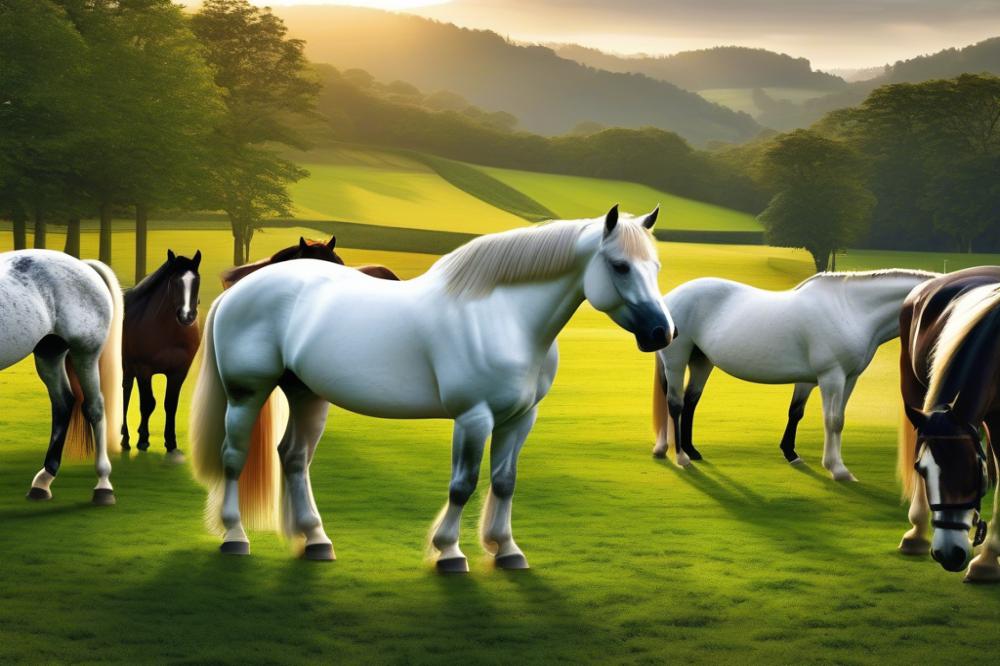Introduction
Horse Breeding holds great significance in the equestrian world. The practice shapes the characteristics and abilities of these magnificent animals. Over the years, careful selection of breeding pairs has led to the development of various breeds tailored for specific purposes. These can range from racing champions to reliable workhorses. Each breed carries its own strengths, personality traits, and skills, all of which enrich our connection with them.
Recent advancements have transformed how breeders approach their craft. Modern Techniques now include genetic testing for desirable traits. This ensures greater precision in breeding choices, enhancing the likelihood of producing offspring that excel in their respective fields. Additionally, methods such as artificial insemination have opened doors for genetic diversity by allowing the use of sperm from stallions located far away. These innovations not only improve breeding practices but also positively impact the overall health and performance of equine athletes.
Ethical considerations play an essential role in contemporary breeding protocols. Breeders are becoming increasingly aware of their responsibilities toward the animals. Prioritizing the well-being of horses means taking steps to minimize health risks. Responsible breeding practices emphasize the importance of avoiding overbreeding and considering the genetic health of both the mare and stallion. The goal is to create a balanced approach that benefits the horses and their future owners.
Horse Breeding: An Evolving Landscape

Horse breeding encompasses the art and science of mating horses to produce desired traits in offspring. Traditionally, this practice has relied on selecting the best stallions and mares based on physical attributes and performance records. Breeders sought out horses with specific qualities, from speed to endurance, to produce foals with high potential. Many relied on observation and instinct, often without understanding the genetic principles at play. This approach worked for centuries, but it had limitations.
Introduction of Reproductive Technology
Recent advancements in reproductive technology have changed how horses are bred. Methods like artificial insemination have made it easier to pair desirable stallions with mares located far away. This process allows breeders to access population genetics and select the best combinations for desired traits. For instance, frozen semen enables breeding at any time of the year. Advances in embryo transfer have also gained popularity among breeders. This technique permits the use of surrogate mares to carry offspring, enhancing breeding programs’ overall efficiency. It has opened doors to more diverse genetic combinations.
Evolution of Breeding Objectives Over Time
Breeding goals have shifted significantly through the years. Initially, many aimed simply to produce strong and reliable workhorses. Today’s objectives also include specialized traits like temperament, health, and athletic ability. Modern breeders often emphasize not just physical performance but also the mental disposition of the horse. The demand for versatile horses has grown, reflecting changing societal needs. People now seek horses for various reasons, from competitive sports to companionship. These evolving requirements highlight a broader understanding of the unique needs within the equestrian community.
Artificial Insemination and its Impact

Explanation of artificial insemination
Artificial insemination (AI) is a method used to breed horses without the need for direct mating. The process involves collecting sperm from a stallion and then introducing it into the mare’s reproductive tract. This technique has become popular in the equine industry. It allows for greater control over breeding.
Advantages over natural breeding
One major benefit of AI is convenience. Breeders can access a wide range of stallions without traveling long distances. This method also reduces the risk of disease transmission between horses. Additionally, it allows for better timing. Since insemination can be precisely scheduled, the chances of successful breeding increase.
Success rates and statistical insights
Success rates for artificial insemination can be quite high. On average, around 60 to 70 percent of inseminated mares become pregnant within one cycle. Factors like the mare’s health and timing of insemination impact these rates. Statistics show that using frozen semen, although more challenging, still yields reasonable success. With advancements in techniques, results continue to improve.
Impact on breeding diversity and reach
AI promotes breeding diversity by allowing access to many bloodlines. Rare or unique stallions can contribute genetically, even when they are geographically distant. Breeders can mix different traits and characteristics easily. This access results in healthier horse populations. It opens up opportunities to create better athletes and companions. The overall reach of breeding programs expands, benefiting the equine community as a whole. Through these methods, the sport and recreational horse world can thrive with new and varied horses.
Innovation in genetic testing

Role of Genetic Testing in Horse Breeding
Genetic testing has changed how breeding is approached. This science allows breeders to analyze DNA samples from horses. Understanding the genetic information can lead to better decisions. Evaluating traits and potential offspring becomes clearer with this technology. Breeders can identify desirable qualities in both physical attributes and temperament. This method is propelling the industry forward.
Understanding Heritability and Genetic Traits
Heritability is the passing down of traits from parent to offspring. Recognizing how specific traits are inherited helps breeders select the right mating pairs. Some features, like coat color or height, have clear genetic links. Certain genetic markers are associated with performance capabilities, too. By studying these factors, breeders can predict how likely a foal will inherit these traits. This understanding is crucial in creating a desired lineage.
Applications in Selective Breeding and Disease Prevention
Selective breeding has become more precise with genetic testing. Breeders can now avoid mating horses that carry harmful genes. This helps reduce the risk of genetic disorders in foals. Identifying carriers of specific conditions is easier, allowing for informed choices. Additionally, experts can work on enhancing traits that contribute to performance and health. It is now possible to create horses that are not only exceptional in skills but also resilient to diseases. This proactive approach shapes a healthier future for equine companions.
Embryo Transfer and Cloning Techniques
Overview of Embryo Transfer Procedures
Embryo transfer is a modern technique that allows breeders to produce foals without putting the mare through the entire pregnancy. In this process, the embryo is harvested from a donor mare after fertilization. This embryo can then be placed in a surrogate mare, who will carry the foal to term. The procedure involves careful monitoring and precise timing to maximize success. After the embryo is collected, it is usually examined to confirm its quality before implantation.
Benefits of Embryo Transfer for Maintaining Mare Health and Enhancing Bloodlines
Using embryo transfer offers several advantages. One major benefit is the health of the mare. This technique reduces the stress and risk associated with carrying a foal for nine months. Another advantage is the potential to enhance bloodlines. Breeders can select the best genetics from a superior mare, allowing them to produce higher quality offspring. As a result, this method can lead to a more diverse and robust equine population.
Introduction to Horse Cloning: Processes, Success Stories, and Ethical Debates
Cloning horses is a fascinating yet controversial topic. The process involves creating a genetic duplicate of a horse. Scientists take a cell from the horse to be cloned and insert it into an egg cell that has had its nucleus removed. This egg cell is then stimulated to develop into an embryo. Once created, this embryo can be transferred into a surrogate mare. Success stories exist of cloned horses excelling in various activities. However, ethical debates simmer within the equine community. Critics question the morality of cloning living creatures. Concerns arise about animal welfare and the implications for genetic diversity. These discussions continue as technology advances.
Nutritional Optimization for Breeding Success
Importance of Equine Nutrition in Breeding
Proper nutrition plays a crucial role in the reproductive health of horses. Nutrients directly impact fertility rates, gestation periods, and foal vitality. A balanced diet helps mares maintain optimal body condition, which is essential for successful breeding. Stallions also require specific nutrients to support sperm production and overall health. Feeding practices should focus on quality forage and supplements that meet the unique needs of breeding animals. When horses receive adequate nutrition, it enhances their ability to conceive and carry healthy offspring.
Nutritional Strategies to Enhance Reproductive Performance
Tailoring diets to the needs of breeding horses can make a significant difference. Key nutrients include protein, energy, vitamins, and minerals. For instance, protein is vital for muscle development and tissue repair. Additionally, energy sources can come from grains or fats, depending on the horse’s workload and condition. Vitamins A, E, and various B vitamins are essential for maintaining overall health. Minerals like calcium and phosphorus help support bone health in developing foals. Consulting with a veterinarian or equine nutritionist can help establish an effective feeding program that targets reproductive goals.
Link Between Horse Health Management and Successful Breeding Outcomes
A comprehensive health management plan is integral to breeding success. Regular veterinary check-ups, vaccinations, and deworming should be part of the routine. Healthy horses are more likely to conceive and give birth to strong foals. Stress management is also important. Factors like excessive travel or overcrowding can affect a horse’s ability to breed. Creating a comfortable environment aids in lowering stress levels. In summary, focusing on nutrition and health maintenance can significantly improve reproductive outcomes for horses.
Advancements in Equine Genomics
Equine genomics represents a significant breakthrough in the understanding of horse breeding. Scientists study the genetic makeup of horses to determine traits and characteristics. This field combines biology and technology to help breeders make informed decisions. By analyzing DNA, experts can identify genes that influence speed, temperament, and physical fitness. It transforms how breeding programs are designed and implemented.
Understanding equine genomics and its role in horse breeding
Genomic research provides a detailed view of a horse’s genetic inheritance. Every breed possesses a distinct genetic pattern. These patterns can reveal information about an animal’s potential performance. With this knowledge, breeders can select horses that complement each other. This blending of genes can enhance overall qualities in the offspring. Improved health and performance can result from such careful selection.
How genomics influences breeding decisions
Genomics significantly impacts breeding strategies. Breeders now have access to tools that guide their choices. Genomic testing can determine the best pairings between stallions and mares. Such precision reduces the risk of passing on undesirable traits. It also enables breeders to make choices based on more than just appearance or pedigree.
Furthermore, understanding genetic markers can pinpoint diseases. This knowledge allows breeders to make decisions that prioritize health. Horses bred with a focus on genetic robustness tend to excel in competitions and work. The process encourages responsible breeding practices, ultimately benefiting the entire equine community.
Future prospects and research directions in equine genetics
The future of equine genetics looks promising. Ongoing research aims to uncover more about horse genomes. Scientists hope to identify additional genes linked to important traits. This research could lead to even better breeding practices in the coming years. Advances in technology may also allow for easier access to genomic information for all breeders.
Potential collaborations between breeders and geneticists may emerge. Such partnerships could lead to innovative breeding programs. As more data becomes available, the understanding of horse genetics will deepen. A comprehensive approach to breeding that combines tradition with cutting-edge science can create exciting possibilities.
Breeding Ethics in Modern Practices
Ethics in horse breeding is an important topic. Many people are concerned about the methods used in creating new horses. Issues arise with practices such as cloning and genetic manipulation. These techniques can change how horses are bred in ways that some may find troubling.
Cloning offers a way to reproduce a horse with specific traits. While it may sound appealing, it raises questions about the individuality of horses. Do cloned animals have the same spirit as their originals? Many argue that this method takes away from the natural process of breeding.
Genetic manipulation is another area sparking debate. By altering genes, breeders can create horses with desirable characteristics. However, this practice can lead to unforeseen health issues. Concerns about the long-term welfare of these horses cannot be ignored.
Welfare is paramount in all breeding practices. Horses deserve to live healthy and fulfilling lives. When breeding practices focus solely on profit or competitive advantage, animals can suffer. Responsible breeding must be at the forefront to protect their well-being.
Some breeders are now adopting more ethical standards. They prioritize health over appearance and performance. Education plays a crucial role in fostering these responsible practices. When breeders understand their responsibilities, they can make better choices.
Broad discussions about ethics help create awareness within the industry. A shift toward compassion and care can lead to positive changes. Respect for all living beings should guide decisions in the breeding world.
Final Thoughts on Modern Breeding Techniques
Recent advancements in breeding practices have transformed how we approach the task of enhancing equine qualities. Techniques such as artificial insemination have opened new doors to genetic diversity. Innovations in genetic testing allow breeders to make informed decisions about lineage and health, leading to stronger, healthier horses. Improved understanding of horse genetics means that desirable traits can be selected with higher precision.
The outlook for future breeding practices seems optimistic. Breeders are increasingly embracing technology, striving for solutions that promote the best traits in horses. New methodologies will likely emerge, driven by ongoing research and passion for equine excellence. As we look ahead, the integration of science and traditional breeding practices will continue to evolve.
Ethics should always play a crucial role in these developments. As breeders pursue advancements, the welfare of the animals must remain a priority. Prioritizing health, longevity, and quality of life for horses is essential. Awareness of ethical standards not only preserves the integrity of breeding practices but also fosters a better relationship between horses and humans. In the end, nurturing a responsible framework for breeding will lead to a brighter future for both horses and their owners.



